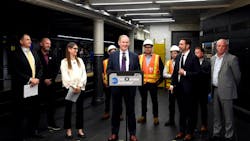MTA partners with Boldyn Network to launch 5G network services on shuttle service
The Metropolitan Transportation Authority (MTA) has fully equipped the Grand Central Times Square 42 St. Shuttle with 5G wireless connectivity services. This was made possible through a public-private partnership agreement with Boldyn Network.
“This is a public private partnership and the capital investment is being made by our private partner. We had an estimate prepared when we finalized our deal on this, that they would be investing $600 million in it and there's a $1 billion total estimated benefit for the riders of the New York City transit system,” said Jamie Torres-Springer, president MTA construction and development. “There is no cost to the MTA, there is no public money and we're excited about that. It's a great way to make improvements in the system.”
Major cell carriers, including Verizon Wireless, AT&T and T-Mobile customers will now have full cell service in the tunnel between Grand Central 42 St. and Times Square 42 St. The network is also designed to provide seamless connectivity for first responders. With bandwidth prioritization, the FirstNet Network will be available for the public safety community’s use.
“MTA has now developed a reputation as a first-class construction operation, getting our projects done on time and on budget: Third Track, Train, Times Square Shuttle, all that work on time and on budget. It's not the old MTA. It's the new MTA,” said MTA Chair and CEO Janno Lieber. “What we're doing here is the most efficient way to bring cell connectivity: Every time we go to do work in a tunnel, we're going to say to our friends at Boldyn, come on in. Be ready, pull that cable. Install that infrastructure. Take advantage of the outage. It's going take a few years, but we're going to make the entire system fully connected in the most efficient way possible, which is during other construction outages.”
This is the first subway line to receive connectivity under a public-private agreement with Boldyn Network, formerly known as Transit Wireless. Boldyn Networks has deployed a high-capacity, low-latency network for all tier-1 mobile carriers to offer fully connected services to their customers. Even during peak commutes, riders will experience an enhanced connection on their mobile devices.
Under the agreement, all 418 track miles of subway tunnel will receive cell coverage. WiFi service will also be expanded to all 191 above-ground subway stations and 21 Staten Island Railway stations. Installation of 5G infrastructure is happening in conjecture with MTA capital projects.
"Our partnerships with the MTA, Verizon, AT&T and T-Mobile underscore Boldyn's long-term commitment to implementing technology in New York City for the better,” said Christos Karmis, U.S. CEO of Boldyn Networks. “This is just the beginning because together, we are modernizing the vital systems that are necessary for how a city moves and communicates in today’s modern world.”
While the G train undergoes a major signal modernization, workers have been laying cables to support the fiber optic and wireless communications system throughout the entire line. The next tunnels to receive connectivity are:
- Joralemon Street Tunnel. A 1.1 mile tunnel connecting the 4, 5 between Manhattan and Brooklyn
- 4, 5 , 6 Grand Central to as far north as 161st St. As this phase of the project develops, five track miles of the 4, 5, 6 will also be upgraded with 5G mobile infrastructure
